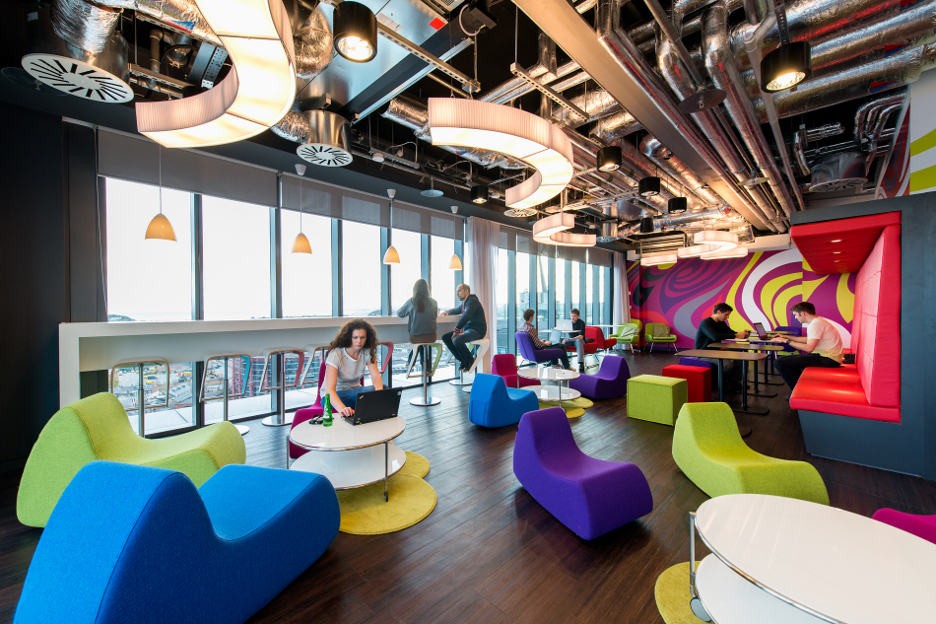The last few days I have been contemplating workplace design as if I was one of the prospective users of the space. It is really interesting to think about because when I picture where I like to work, it is very different from a traditional workplace environment. Often we have been told in classes that workplace design is shifting because of the younger generations that are coming into the workforce. Lately I have been realizing how true this is. The younger generations (myself included) are requiring flexible environments. We do not want to be limited in any way. In fact, when thinking about how I get most work done, I realized that I do not like to sit in the same position or in the same spot for very long. Sometimes I want to be at a typical desk. Other times I want to be on a sofa using my laptop. This shift in expectations has created an interesting challenge for designers. Before, when everyone simply had a desk or cubicle, designing a space did not require as much creativity and utilized fewer types of furniture. Each person could have the exact same workspace and no one expected otherwise.
 https://capstonerealty.wordpress.com/2013/04/09/office-design-debate-open-space-versus-the-cubicle/
Above: A fairly typical image of a cubicle-filled work space
Below: An area in Google's office in Dublin shows a creative area with options and an open feel
https://capstonerealty.wordpress.com/2013/04/09/office-design-debate-open-space-versus-the-cubicle/
Above: A fairly typical image of a cubicle-filled work space
Below: An area in Google's office in Dublin shows a creative area with options and an open feel
 http://www.home-designing.com/2013/02/googles-new-office-in-dublin
http://www.home-designing.com/2013/02/googles-new-office-in-dublin
However, now we are desiring a more diverse workspace: different areas where different seating types are offered, different colors shapes sizes, tables, no tables etc. We want the ability to be alone, or in a group, we need time to chat and bounce ideas off of each other, and then turn back around and then get work done individually. However, In most offices where older and younger generations are very mixed, the design of the space has to work for both. This causes designers to be in a transition stage of trying to design for the older and the younger generations simultaneously. However, a shift is happening in office designs and I believe that "open," "varied," and "flexible" are words that will soon describe the majority of workplaces' designs.


I liked your post because I love workplace design and am pretty interested in it. I think that the generation gap is for sure a big factor in how the workplace is changing. A "flexible" work area leads to a much more productive day and more interaction, due to the changing formation of furniture. After a long day of working in the studio, it's safe to say a change of scenery would be nice. Even a reconfiguation of the space would be positive to keep the energy of the day up. I think not only does flexibility in the workplace work because of it's functionality, but also for the emotional response as well.
ReplyDeleteThis post does a great job describing where workplace design is heading. We have learned a lot about these trends in school and this post does a great job summarizing them. It is so relevant to not only the projects we are designing but our job searches as we enter the work force. We all are use to the college/flexible mentality so transferring into a traditional office mindset will be a challenging transition. It may be so important to have this flexible workplace set-up to some that they may base where they take their job solely on that factor.
ReplyDeleteI really enjoyed this post, especially since we've been introduced to workplace design so much lately. Looking at different perspectives is always beneficial to creating the most successful workplace design!
ReplyDeleteI think one of the biggest challenges we face as designers when designing workplaces is bridging the many styles of work. It's not just the different styles though there are different generation's perceptions of how the workplace should be structured. Meshing these perceptions and preferences creatively and with finesse is very important in order for us as designers to give them a space that is cohesive and not disjointed and alienating to anyone.
ReplyDeleteThere are so many factors that go into workplace design, but I think above all the user is the most important. By providing various spaces allows one to accomplish tasks or to take a step away throughout the workday.
ReplyDelete